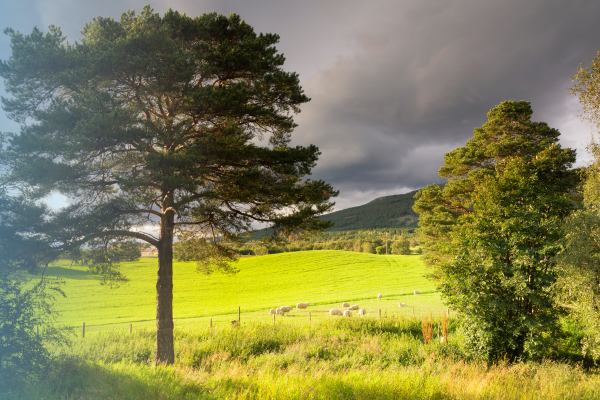Step by Step Guide to a DIY Carbon Audit
11 July 2025Farmers, crofters and land managers can complete a carbon audit themselves to meet the Whole Farm Plan requirements. Regardless of which tool you are going to use, the steps that you need to complete are the same.
This article will take you through what you need to prepare and collate to complete a carbon audit for the Whole Farm Plan.

Step 1 - Ensure the data you're using is accurate
Without accurate data, it becomes harder to properly measure the changes to emissions your business makes over time as you implement improvements and become more efficient. This article will help you understand how inaccurate data for some elements will skew your result. The example used in the article is beef enterprises, but the impact of inaccurate data applies to all enterprises.
Step 2 - Gather the necessary information as described in our data checklist
This checklist will help you prepare and collate your farm data for the 12-month period you are assessing before you are sat in the front of the tool. This can be especially valuable to use if some of the information will be held by other business or family members.
https://www.fas.scot/article/how-to-get-prepared-for-a-carbon-audit/
Step 3 - Select your carbon audit tool
There are 4 free tools available and you can select which tool you would like to use from the list below. You can find out more about each tool on their respective websites.
Step 4 - Access your chosen platform via one of the following methods:
- Login if you have existing credentials
- Register for the first time
- If you have previously had an account with a carbon calculator but it needs re-activated then contact the carbon calculator team for that platform directly.
Step 5 - Upload your farm data onto the tool
Make sure to pay close attention to the units of the data fields. For example, kilograms rather than tonnes.
Watch a demo of how to enter the data on Agrecalc
The principles of the data entry will be very similar across platforms but the example of Agrecalc has been used below to allow you to visualise the principles of carbon auditing before you begin your own data entry.
If the option is available, submit the data for checking by the carbon calculator team
If you were able to submit for checking, please do not continue until you have heard back from the carbon calculator team that your report was completed correctly.
Step 6 - Once your report is finalised, download your results/report and save or print for ease of retrieval at a later date
This is an important step as a copy of the carbon audit will be required for Basic Payment Scheme inspections.
Step 7 - Assess the results for your carbon audit
Aiming to identify the areas that offer the greatest scope for improvement. Focus on the opportunity level showing within the tool rather than the numerical figure.
What to do with your results
Your results should give you a clearer picture of where improvements can be made to your business. The highest opportunity level is a great place to start. Once you’ve identified your greatest opportunities, you can use our library of resources to help you improve your emissions.
Click on each dropdown to reveal the available resources.
Overview
Scotland's Dairy Sector's Progress Towards Net Zero 2045 | Helping farmers in Scotland
Alternative Bedding
Breeding
Low Emissions Livestock Breeding - The What and the Why | Helping farmers in Scotland
Grazing Methods
Nutrition
Silage Testing - Interpreting Results Practical Guide
Overview
How to Interpret Your Soil Analysis | Helping farmers in Scotland
Breeding
Calving Pattern & Fertility | Helping farmers in Scotland
What should your Voluntary Waiting Period be? | Helping farmers in Scotland
Optimising Fertility in Dairy Heifers | Helping farmers in Scotland
Culling
Culling Within The Dairy Herd | Helping farmers in Scotland
Electricity & Fuel Use
Electricity Use in Dairy Practical Guide
Fertility
Improving Fertility in the Dairy Herd Practical Guide
General
Carbon Audits for the Dairy Farm | Helping farmers in Scotland
Carbon Footprinting in the Dairy Herd
How Do We reduce Emissions from Dairy Practical Guide
Health
Lameness | Helping farmers in Scotland
Mastitis and antibiotic use | Helping farmers in Scotland
Parasite Health | Helping farmers in Scotland
Housing
Improving Shed Ventilation for the Dairy Herd
Building Ventilation Video Calves | Information helping farmers in Scotland | Farm Advisory Service
Nutrition
Improving Dairy Feed and Water Intakes
Improving Feed Conversation Efficiency and Reducing Waste in the Dairy Herd
Nutrition of dairy cows | Farmers in Scotland | Farm Advisory Service
Technical Note (TN681): Nutritional Management for Artificially Reared Calves
Overview
Livestock Productivity - Beef | Helping farmers in Scotland
Agroforestry
Agroforestry for Beef and Sheep Farmers
Breeding
Calving Heifers Vlog Series | Helping farmers in Scotland
Bull Fertility
Working Towards Net Zero Carbon Emissions - Managing Bull Fertility
Calf Nutrition
Colostrum for New Born Calves (YouTube)
Fertility
Improving Fertility in the Beef Herd
General
Carbon Footprinting on the Beef Farm
How Do We Reduce Emissions from Beef
Grazing Strategies
Mob Grazing With Beef Cattle | Information helping farmers in Scotland | Farm Advisory Service
Growth
Health
Calf Scour Prevention (YouTube)
Faecal Egg Count for Cattle (YouTube)
Housing
Improving Shed Ventilation for the Beef Herd
Building Ventilation Beef Cattle | Information helping farmers in Scotland | Farm Advisory Service
Nutrition
Ruminant Nutrition and Forage Analysis
Finishing Cattle at Grass and when to Supplement | Helping farmers in Scotland
Creep Feeding Spring Born Suckler Calves | Helping farmers in Scotland
Nutrition/Fertility
Feeding for Fertility in the Suckler Herd | Helping farmers in Scotland
Parasites
Managing Parasites in Beef Cattle - Lungworm
Managing Parasites in Beef Cattle - Roundworm
Managing Parasites in Beef Cattle - Live Fluke
Selling Stores
Case Study for the Beef Supply Chain
Tool
Carbon Tool | Farm Advisory Service
Overview
Livestock Productivity - Sheep | Helping farmers in Scotland
Agroforestry
Agroforestry for Beef and Sheep Farmers
Fertility & Growth
Improving Ewe Efficiency - Meeting Benchmarks
Pre-Lambing Management of Hoggs
Fertility & Survival
Improving Ewe Efficiency - Pre-Lambing
General
How Do We Reduce Emissions from Sheep
Growth
Improving Ewe Efficiency - Meeting Benchmarks Post-Lambing
Nutrition
Nutrient Budgeting
Nutrient Budgeting I - Benefits to your Business
Nutrient Budgeting II - Getting Started
A Quick Guide To Nutrient Management Plans | Helping farmers in Scotland
Use of Manures
Technical Note (TN736): Optimising the Application of Livestock Farmyard Manures and Slurries
Use of Fertilisers
Reduced Tillage
Profiting From Reducing Tillage and Lowering Emissions Case Studies | Helping farmers in Scotland
Regenerative Agriculture - Transitioning to Reduced Tillage
Managing Cropping Inputs
Reducing Fertiliser Use and Improving Soil Health - A Case Study | Helping farmers in Scotland
Resource Use Efficiency on Arable Farms
Managing your Carbon Footprint in an Arable Setting
Climate Change - Crops & Soils Webinar Recording (YouTube)
Crop Rotation
Benefits of Multi-Species Grassland Leys for Arable Farming | Helping farmers in Scotland
Soil Analysis
Interpreting Grassland P & K Soil Analysis | Helping farmers in Scotland
How to Interpret Your Soil Analysis | Helping farmers in Scotland
Cover Crops and Green Manures
Cover & Catch Crops | Helping farmers in Scotland
CropCast - Cover Crops & Green Manures | FAS
Nutrient Strategy - Green Manures | Information helping farmers in Scotland | Farm Advisory Service
Soil Sampling
Soil Sampling I - Taking a Soil Sample
Soil Sampling II - Benefits to the Business
Soil Analysis
Interpreting Grassland P & K Soil Analysis | Helping farmers in Scotland
How to Interpret Your Soil Analysis | Helping farmers in Scotland
Liming and Use of Inhibitors
Silage Sampling and Analysis
Benefits of Analysing Your Silage ASAP | Helping farmers in Scotland
Silage Sampling – Taking A Representative Sample | Helping farmers in Scotland
Silage Testing - Interpreting Results
Use of Manures
Use of Poultry Manure as a Fertiliser for Grassland
Technical Note (TN736): Optimising Application of Livestock Farmyard Manures and Slurries
Use of Fertilisers
Grassland Management
Maximising Performance of Grass Leys
Use of Forage Crops
Field and Crop Choice for Fodder Crops in 2024 | Helping farmers in Scotland
Technical Note (TN733): Forage Crops for Livestock
Fodder Beet | Helping farmers in Scotland
Rotational Grazing
Getting Started with Rotational Grazing for the Dairy Herd | Helping farmers in Scotland
Use the Specialist Advice Plan funding or FAS Advice Line if you have further queries or outstanding questions about recommendations to improve your carbon footprint
More information can be found at www.fas.scot/specialist-advice/ or by contacting the advice line on
0300 323 0161 or advice@fas.scot
Sign up to the FAS newsletter
Receive updates on news, events and publications from Scotland’s Farm Advisory Service

